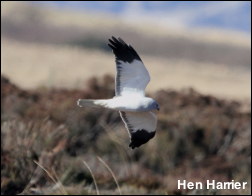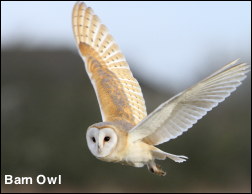March 31, 2013 at 2:34 pm
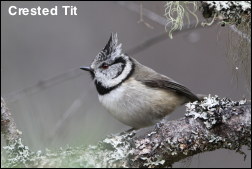
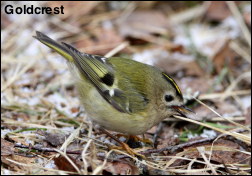
We have just returned from six days in the Spey Valley with snow flurries most days but good sunshine and a temperature of -6°C on Friday.
Walks in the Caledonian pine forest produced good sightings of Crested Tits with plenty of photos taken. In addition a Goldcrest fed on the ground below the feeders put up for the Crested Tits and several times fed between the legs of my tripod! It was amazing to watch our smallest bird at such close quarters without any fear in my presence. At Loch Garten on 27th March the female Osprey arrived back from Africa to claim her nest for the season. Unfortunately, with the low overnight temperatures all the Lochs were frozen and her fishing will have to be done on the river Spey.
In the Findhorn Valley a Golden Eagle made an unsuccessful attempt to catch a Red Grouse which was in a flock of sixty birds. In was a spectacular sight to see them all take off over the snow in panic. On another sheltered slope one hundred and eighty Red Deer were grazing and I have never seen such a large gathering before. On the open moor two Red Kites were present plus five Bullfinches, which were feeding on heather seeds.
With heavy snow on the Cairngorm mountains it was impossible to go searching for Ptarmigan and even the Snow Buntings failed to put in an appearance . However, with perfect Wintry weather Speyside is a magical place to visit.
You can see more photos from this past week on my Facebook page by Clicking Here
March 23, 2013 at 7:18 pm


Last week I mentioned the Mountain Hares and I now show one in its form and the other about to run.
During the week the East wind has continued to blow and the Waxwings have been held up. There were ninety four in Rochdale on the seventeenth, sixteen near Hollingworth Lake on the eighteenth and I even found twenty two at dawn on the twenty first in Bacup. On Hopwood there was a Woodcock on the twentieth together with two Goldcrests and Two Buzzards. Better still Long Tailed Tits were building a nest in a gorse bush – the first I have found this year nearly three weeks later than last year.
Today we have had snow for most of the day and a record five Robins were feeding in the garden together.
March 18, 2013 at 8:40 am
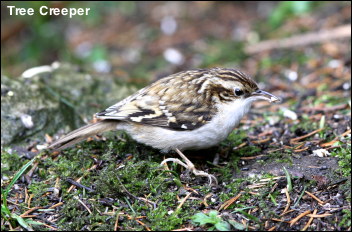
After forty five years of feeding birds in the garden on the fifteenth a new bird fed all afternoon – it was a Tree Creeper. Luckily it came several times to eat the bits off the fat balls that were on the ground and I managed to take a photo. IT was a one day wonder and has not returned since so I was very fortunate to be at home that afternoon.
Most of the week has been spent watching Waxwings around Rochdale with over eighty birds being present on several days. Unfortunately very few photographs were obtained and one freezing day I waited two and a half hours along side a berry laden bush and every time the Waxwings fed on the other side of bush where all the traffic was! To make matters worse it was my birthday.
On a calm sunny morning I ventured onto the high Pennines to search for Mountain Hares in their Winter coats. It was a fabulous morning and I came across many hares with one in its form enabling me to obtain some good close ups of an animal I respect and admire in having to survive at that altitude. The Red Grouse were also very active and several Golden Plover had returned to their old breeding sites, although with the snow that has followed they have nor probably returned to lower pastures.
March 10, 2013 at 1:14 pm
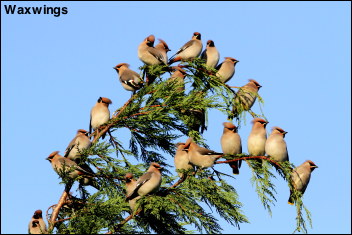
What a Winter it has been for Waxwings with good numbers of them waiting for the strong East winds to drop before returning to their breeding grounds. On the sixth I watched twenty seven feeding in Newhey and better still on the ninth seventy three fed all day on berries in Milnrow. I have to feel sorry for a fellow Waxwing enthusiast who, all Winter long, has checked the Milnrow bush for feeding Waxwings and the very weekend he goes on holiday they appear and clean up – that’s the sort of luck I normally have!
During the week the garden birds have been fantastic with twenty five different species feeding on the eighth. These included our single Willow Tit together with three SIskins, two Song Thrushes, four Jays,seven Bullfinches (four male three female) and a record six Reed Buntings.
On Hopwood two Woodcock were still present on the ninth with all the usual water filled hollows containing frog spawn. Let’s hope it doesn’t freeze!
February 25, 2013 at 6:17 pm
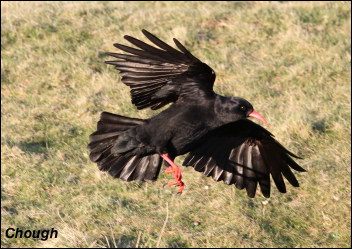
A week on Islay with two superb Winter days and the rest dry with a cold South East wind. I came to concentrate on flight shots of `Chough and I have had two great days with shots like the one featured on my blog.
During the week we have seen two Otters and both eluded the camera. HenHarriers have appeared daily with Merlin, Sparrowhawk and Kestrel observed on some days. Three pair of Ravens have been building their nests on cliffs so the breeding season is now under way.
Amongst a flock of two hundred finches in a stubble field there was one male Brambling present.








